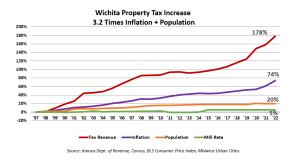Across Kansas, hundreds of taxing entities from local school districts, townships, counties and even cemeteries are planning on raising taxes. However, because of the state’s Truth-in-Taxation laws, entities planning on raising taxes need to hold a public hearing and vote on the issue between August 20th and September 20th this year. Taxpayers have the opportunity to speak with their local officials about their how they’re adjusting to the increasing cost of living and whether governments get to take a bigger bite.
KPI sent KORA requests to all 105 counties in the state to assemble a database of all revenue-neutral hearings this year. The results can be viewed here, on the Kansasopengov.org website. The website is being updated daily as requests come in and are processed. As of this article, there are 1,883 entities representing 53 counties, including the most populous like Johnson, Sedgwick, Wyandotte, Shawnee, and Douglas.
For decades, authorities across the state had honesty problems with taxpayers: they would say they weren’t increasing the mill rate, yet tax collections kept increasing annually. At Wichita’s revenue-neutral rate hearing last year, Mayor Brandon Whipple had this same rhetoric and said “for 28 years, we have held the line on our percentage of the mill levy.” From 2020 to 2022 while Whipple was in office, Wichita’s annual tax collections have increased by 11.5% – that’s $14.4 million a year.
But that’s not the full story. If appraisals go up and the mill rate isn’t changed, then the taxes that people pay are going to increase. Between 1997 and 2022, the total property tax collected in Wichita increased by 177.8% while the mill rate increased by 5.4%. At this same time, population only grew by 20% and inflation by 74%. So while the mill rate didn’t increase by much, the taxes that people are paying have vastly outpaced the growth of the city. The honesty gap – that is, the difference between the growth in the mill rate that officials would praise versus the growth in the actual tax collections – is 172.4%. The same information on other cities and every county can be found on KansasOpenGov.org.

This year, the City of Wichita’s revenue-neutral rate was calculated at 30.038 mills. At that rate, the city would have collected the same dollar amount of tax as last year. Instead, the city proposed a mill rate of 32.762 – a 9.1% increase – and is having a hearing on August 22nd at 9 AM at the Wichita City Hall to approve or reject it.
Of the 1,883 entities currently uploaded, 864 taxing entities are planning on exceeding their revenue-neutral rate and have published public meeting details.
However, 54.1% of taxing entities have already decided they’re not raising taxes for next year. Counties like Reno, Gray, and Franklin have already decided to stay at the revenue-neutral rate.
In 2021, about 52% of all local taxing authorities decided to not increase property tax. Last year, 56% decided to not increase taxes; 13% imposed less than a 5% increase, 11% had increases between 5% and 10%, and 19% imposed tax hikes greater than 10%.
Truth-in-taxation comes down to transparency: officials have to be honest when they propose a tax increase and are on the record voting to approve it. Last year, Leavenworth USD 453 was considering an 8.6% tax hike, but instead voted to maintain the district’s revenue-neutral rate after testimony from constituents about their struggles with high prices.




